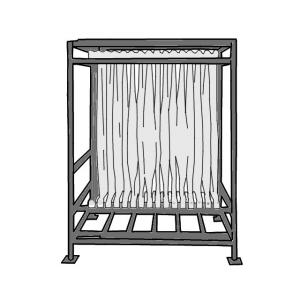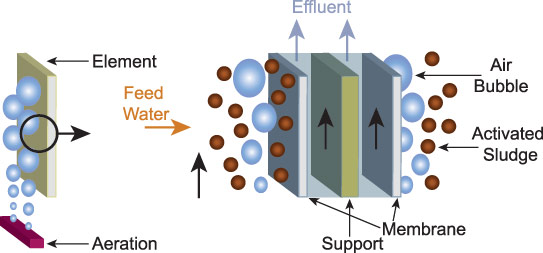How Membrane Layer Bioreactors Are Transforming Water Filtration Systems
The introduction of membrane bioreactors (MBRs) represents a substantial advancement in the field of water filtration, combining organic treatment procedures with sophisticated membrane layer filtering modern technologies. As international water shortage increases, the function of MBRs in facilitating safe and clean water reuse and sustainable water monitoring ends up being progressively vital.
Overview of Membrane Bioreactors
Membrane bioreactors (MBRs) represent a significant improvement in water purification modern technology, as they combine biological treatment processes with membrane layer filtering. This combination enhances the effectiveness of wastewater treatment by making use of microbes to break down natural contaminants while all at once utilizing semi-permeable membrane layers to different cured water from suspended solids and virus.
The MBR system typically contains a biological activator where the microbial populace metabolizes contaminants, adhered to by a membrane filtration system that keeps biomass and allows only clean water to pass through. This twin functionality results in higher effluent high quality contrasted to standard therapy methods. MBRs can be operated in both set and continuous circulation settings, offering flexibility in style and application.
They additionally enable the recovery of water for reuse, therefore contributing to water sustainability efforts. On the whole, MBRs are at the forefront of enhancing water therapy performance and top quality, showcasing the potential for ingenious options in ecological monitoring.
Advantages of MBR Technology
The integration of biological treatment with membrane layer purification offers various advantages for water purification processes. One of the main advantages of Membrane layer Bioreactor (MBR) innovation is its capacity to effectively remove both organic and inorganic impurities, resulting in high-grade effluent. The membrane layers work as a physical obstacle, avoiding suspended solids and microorganisms from travelling through, which boosts the overall safety and integrity of cured water.
In addition, MBR systems require a smaller impact contrasted to standard treatment approaches, allowing for much more reliable space usage. This small style is especially beneficial in urban settings where land is limited. MBRs also demonstrate functional adaptability, fitting varying influent qualities and circulation rates without considerable efficiency degradation.
Additionally, the procedure uses enhanced nutrient removal capacities, specifically for nitrogen and phosphorus, which are vital for protecting against eutrophication in receiving waters. The lowered sludge production connected with MBR technology also converts to lower disposal costs, making it a cost-efficient option in the future - Membrane Bioreactor. Generally, the advantages of MBR technology placement it as a leading option for sustainable and ingenious water filtration systems, addressing both environmental and financial issues
Applications in Water Purification
Applications of Membrane Layer Bioreactor (MBR) modern technology in water purification are impactful and diverse, attending to numerous treatment requires across several fields. MBRs successfully incorporate organic therapy procedures with membrane filtration, making them suitable for local wastewater therapy, commercial effluent administration, and also drinkable water reuse campaigns.
In municipal settings, MBRs are significantly employed to improve the high quality of treated wastewater, enabling compliance with rigid discharge guidelines and facilitating the recycling of water for irrigation and non-potable usages. Their portable layout additionally makes them suitable for metropolitan environments where space is limited.
Industrially, MBR technology is made use of to treat process water and wastewater, particularly in sectors such as food and drink, drugs, and textiles. By effectively like it eliminating contaminants and suspended solids, MBRs assist markets minimize environmental effects while recouping beneficial sources from wastewater streams.
Furthermore, MBRs are gaining traction in decentralized water treatment applications, where small-scale systems can be deployed in remote areas or establishing areas. This flexibility makes it possible for neighborhoods to accomplish lasting water monitoring options, enhancing access to tidy water while reducing dependence on typical treatment techniques.
Case Research Studies and Success Stories

In an additional instance, a textile production center in Bangladesh embraced MBR modern technology to address its wastewater challenges. The system reduced chemical oxygen demand (COD) levels from 1,200 mg/L to less than 100 mg/L, thus satisfying regulatory standards and considerably decreasing ecological effect.
The College of Cape Community's MBR installment has shown effective in treating greywater for non-potable reuse on university. This job not only conserves safe and clean water but additionally functions as an educational version for sustainable techniques.
Additionally, a fish and shellfish processing plant in Norway made use of MBR technology to treat effluents including high levels of organic issue, achieving over 90% toxin removal. These study highlight MBR technology's convenience and its important role in improving water quality across varied applications.
Future of Water Therapy Solutions
As why not try here global water scarcity and pollution challenges escalate, ingenious water therapy options are ending up being significantly vital to ensure lasting accessibility to clean water. The future of water therapy exists in the integration of sophisticated technologies that improve the effectiveness and performance of filtration processes. Membrane layer bioreactors (MBRs) are at the forefront of this advancement, combining organic therapy with membrane layer purification to create high-quality effluent ideal for various applications.

Emerging patterns such as resource recovery from wastewater, including nutrients and power, will certainly further transform treatment facilities check my reference into environment-friendly centers. Additionally, innovations in nanotechnology and membrane layer products promise boosted performance and long life of filtration systems.

Conclusion
Finally, membrane bioreactors stand for a substantial improvement in water purification modern technologies, properly incorporating biological treatment with sophisticated membrane purification. The many benefits, including boosted effluent quality and lowered spatial requirements, make MBRs particularly appropriate for metropolitan applications. Their function in drinkable water reuse and sustainable water administration highlights their importance in dealing with worldwide water scarcity challenges. Proceeded research and growth will even more improve the effectiveness and fostering of MBR technology, guaranteeing a resilient future for water therapy services.
The emergence of membrane layer bioreactors (MBRs) stands for a significant improvement in the field of water purification, combining organic treatment processes with advanced membrane purification modern technologies. As international water shortage heightens, the duty of MBRs in facilitating potable water reuse and sustainable water administration becomes increasingly vital. They additionally enable the recuperation of water for reuse, therefore adding to water sustainability efforts.As global water shortage and pollution challenges intensify, innovative water treatment services are coming to be significantly essential to make sure lasting accessibility to clean water. Their duty in safe and clean water reuse and lasting water management highlights their relevance in attending to global water scarcity obstacles.
Comments on “How Membrane Bioreactor Can Improve the Quality of Wastewater Treatment”